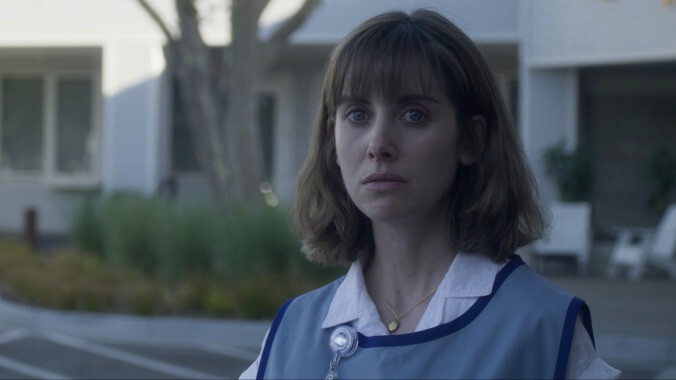Alison Brie commits to the slyly funny but frustratingly ambiguous Horse Girl


Trauma sprawls outward in Horse Girl, a new drama from filmmaker Jeff Baena and actor and co-writer Alison Brie. The movie’s twee dressings—woven friendship anklets, colorful God’s eye votives, and, well, horses—decorate an uncomfortable portrait of a young woman struggling with loneliness and isolation. Horse Girl is sympathetic to Brie’s character, but the film’s ambiguous ending undermines its thoughtful consideration of mental illness.
On the gamut from extraordinary to unremarkable, thirtysomething Sarah (Brie) exists somewhere in the middle. She’s an efficient salesperson at the arts and crafts store Good Lengths, chatting knowledgeably about tempera versus acrylic paint and the differences in various fabrics. She gets along well with her boss, Joan (Molly Shannon), and is friendly with the other salespeople, lighting up when a younger coworker chats about her high school crush. She’s also congenial with her roommate, Nikki (Debby Ryan), who usually retreats to her bedroom with her judgmental boyfriend (whom the movie mocks relentlessly for his aspiring-mumble-rapper affectations) when Sarah is obsessively watching the supernatural-influenced crime procedural Purgatory. Besides that pastime and hours spent sweating hard at Zumba class, Sarah fills her free time with almost daily trips to stables outside of town to visit her horse, Willow, whom she used to ride when she was younger.
Incrementally, this carefully maintained air of normalcy begins to dissipate, ushered along by a series of clever plot reveals. Willow has a new rider, and though Sarah pointedly coaches her, the girl is not—as the film initially implies—her daughter. (The teen, who treats Sarah with the polite distance of a stranger, can’t speed-walk to her mother’s car fast enough.) Although Sarah tells Joan she doesn’t know much about her family, a shoebox of old photographs offers glimpses of relatives, including a maternal grandmother to whom Sarah bears a very close resemblance. It’s through dream sequences of a white room and a glowing portal that Horse Girl moves fully into a reality-questioning direction. “My mom used to say that I have an overactive imagination,” Sarah tells Nikki when she comes home in the middle of the night after an inexplicable sleepwalking episode. But does that really explain what’s going on?
Brie undergoes an impressive transformation, investing herself physically and emotionally into a character whose paranoia bursts to the surface in manic flashes. She lends Sarah an initially charming and sunny disposition, whether flirting with an unexpected suitor during her birthday party, lavishing tender attention on Willow, or implying years of friendship with Joan in the easy, early chemistry between her and Shannon. So the contrast is shocking once Brie begins mutating her heroine—through random nosebleeds and lost time—into someone progressively disconnected from her own body and only intermittently aware of her surroundings. Baena, who previously directed Brie in The Little Hours and Joshy, demarcates the phases of Sarah’s metamorphosis through the repetition of key images: Willow’s eye, water flowing down a drain, verdant tree branches seemingly floating in a blue sky. He also creates jarring transitions between dreams and reality, matching the film’s changing mood through the use of a score that moves from cheery to eccentrically experimental.
Horse Girl’s big weakness is that it can’t decide how much ambiguity to provide its central character, or how seriously it wants to present Sarah’s breakdown (or, if you read the film another way, her awakening). By refusing to clarify its plot, the film flattens its message about the inherited possibility and genetic trauma of mental illness. Sarah is plainly an unreliable narrator, and Baena ensures that details about the character’s personality operate in conversation with her journey. (Her favorite show being called Purgatory says quite a bit). But the gamification of the story cheapens it, so that an interesting character study starts looking—with the introduction of outlandish elements—more like a puzzle box in need of solving. This doesn’t totally paralyze Brie’s strong performance. But the muddled message does hobble it.